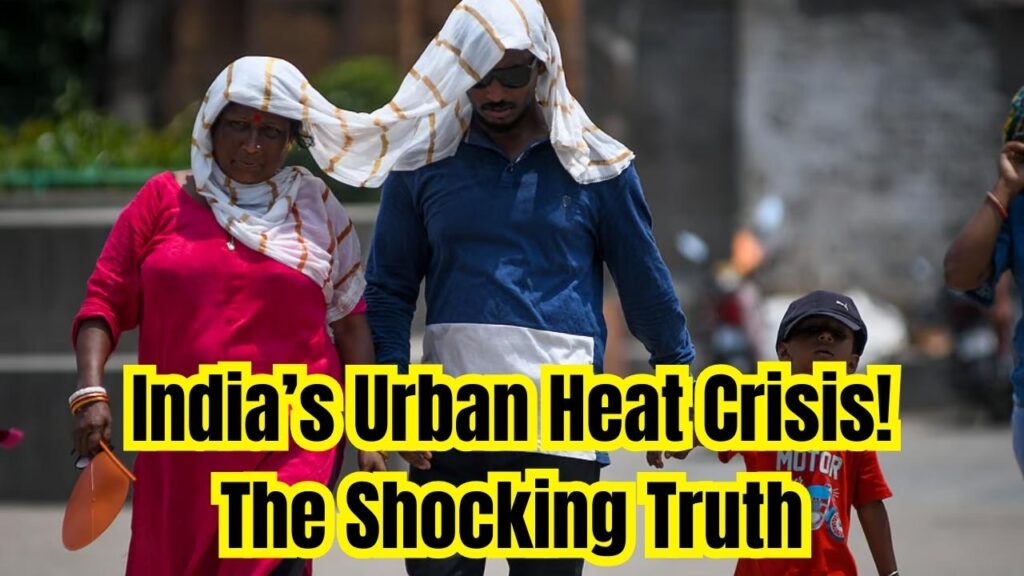
As India’s 2025 heatwave crisis intensifies, the question on everyone’s mind is: Are our cities really prepared to face the heat? A new report by the Sustainable Futures Collaborative (SFC) paints a sobering picture that demands urgent attention from policymakers, urban planners, and citizens alike.
In recent years, India has witnessed increasingly severe and frequent heatwaves. But 2025 is shaping up to be the most challenging year yet. The heat isn’t just uncomfortable—it’s deadly. With over 11% of the country’s urban population residing in the most at-risk cities, there’s growing concern about the effectiveness of current preparedness strategies.
India’s 2025 Heatwave Crisis
| Aspect | Details |
|---|---|
| Study by | Sustainable Futures Collaborative (SFC) |
| Cities Analyzed | Bengaluru, Delhi, Faridabad, Gwalior, Kota, Ludhiana, Meerut, Mumbai, Surat |
| Urban Population Covered | Over 11% of India’s urban population |
| Main Concern | Lack of long-term heat mitigation planning |
| Short-Term Measures | Drinking water access, adjusted work hours, hospital readiness |
| Key Challenges | Staff shortages, poor departmental coordination, technical gaps |
| Workshop Held By | National Disaster Management Authority (NDMA) with global partners |
| Recommendations | Urban greening, cool roofs, city-level Heat Action Plans (HAPs) |
India’s 2025 heatwave crisis is not just a natural event—it’s a wake-up call. Cities must evolve from reactive to proactive, integrating climate resilience into every level of planning and governance. While the challenges are daunting, the solutions are within reach. With the right policies, community engagement, data-driven decisions, and long-term vision, India can beat the heat and safeguard its future.
Why Heatwaves Are a Growing Threat in India
India is no stranger to extreme weather, but heatwaves have become more intense, prolonged, and widespread in recent years. According to the India Meteorological Department (IMD), the average number of heatwave days has doubled in the last two decades, with some regions experiencing temperatures soaring above 48°C (118°F).
Vulnerable populations such as the elderly, children, outdoor workers, and the urban poor are disproportionately affected. But beyond human health, heatwaves also cause economic losses due to reduced labor productivity, crop damage, and strain on electricity and water systems.
Are Indian Cities Ready?
The report by SFC examined nine major Indian cities. Here’s what they found:
- Short-term response plans are somewhat in place, like providing water stations, adjusting school and work hours, and opening cooling centers.
- Long-term plans are either missing or poorly implemented.
- There’s limited coordination among departments, with many city planners unaware of the severity of heat risks.
For instance, Mumbai has some community awareness programs, but lacks a city-wide Heat Action Plan. In Delhi, certain departments are prepared, but there’s no central strategy connecting them. Meanwhile, Kota and Gwalior face significant resource constraints.
What Needs to Change: A Step-by-Step Guide
1. Strengthen Heat Action Plans (HAPs)
HAPs are strategic documents outlining actions before, during, and after heatwaves. Cities like Ahmedabad have pioneered successful models. A strong HAP should include:
- Risk assessment using heat mapping tools
- Communication strategies targeting vulnerable groups
- Emergency response coordination between health, water, and civic agencies
2. Invest in Urban Greening and Cooling Infrastructure
Green spaces, tree cover, and reflective building materials help lower urban temperatures. Cities should:
- Expand parks and rooftop gardens
- Implement “cool roofs” with white paint or heat-resistant materials
- Enforce zoning laws that prioritize shaded areas
This not only cools cities but also improves air quality and mental well-being.
3. Build Climate-Resilient Governance
Departments need to talk to each other. Cities must:
- Appoint heat officers or dedicated climate resilience staff
- Conduct annual drills and training for government workers
- Align climate policy with public health, water, and infrastructure plans
4. Engage the Community
People are both the most vulnerable and the most powerful agents of change. Community engagement should involve:
- School programs to educate children about heat safety
- Local NGOs distributing cooling kits and water
- Media campaigns on heatwave alerts and precautions
5. Explore Innovative Financing
Funding is a major barrier. Cities should consider:
- Public-private partnerships
- Green bonds and climate funds
- International grants for pilot cooling projects
6. Leverage Technology and Data
Smart city technologies can offer proactive insights. Cities should:
- Install urban heat sensors and early warning systems
- Use GIS-based tools for heat vulnerability mapping
- Develop mobile apps for real-time alerts and advice
7. Policy Integration and Legislative Backing
Urban climate resilience requires strong policy support. Consider:
- Integrating heatwave response into national and state urban development policies
- Mandating heat-resilient infrastructure in building codes
- Offering incentives for sustainable design and materials
Real-World Example: Ahmedabad’s Heat Action Plan
Ahmedabad was one of the first cities to adopt a comprehensive Heat Action Plan in 2013. Since then, the city has seen a 30% reduction in heat-related deaths. Their success came from:
- Cross-sector collaboration
- Real-time weather alerts
- Targeted outreach to slum areas and outdoor workers
This model is now being replicated in other cities.
FAQs On India’s 2025 Heatwave Crisis
Q1. What is causing the increase in heatwaves in India?
A combination of climate change, urbanization, and deforestation is amplifying the heat island effect in cities.
Q2. What is a Heat Action Plan (HAP)?
A HAP is a city’s playbook for dealing with heatwaves. It includes early warnings, emergency actions, and long-term mitigation strategies.
Q3. How can individuals protect themselves during a heatwave?
- Stay hydrated
- Avoid outdoor work during peak hours
- Wear light, breathable clothing
- Use wet towels or fans for cooling
Q4. What role does the NDMA play in heatwave preparedness?
The National Disaster Management Authority (NDMA) provides guidelines, funds, and training to help states and cities prepare for extreme heat.
Q5. How can businesses contribute to heatwave preparedness?
Businesses can install cool roofs, provide flexible work hours, support employee hydration, and participate in corporate social responsibility (CSR) initiatives for local heat mitigation projects.







